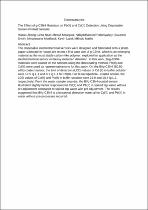 ResearchSpace
ResearchSpace
The effect of g-C3N4 materials on Pb(II) and Cd(II) detection using disposable screen-printed sensors
JavaScript is disabled for your browser. Some features of this site may not work without it.
- ResearchSpace
- →
- Research Publications/Outputs
- →
- Journal Articles
- →
- View Item
| dc.contributor.author |
Zheng, Haitao

|
|
| dc.contributor.author |
Ntuli, Letta

|
|
| dc.contributor.author |
Mbanjwa, Mesuli

|
|
| dc.contributor.author |
Palaniyandy, Nithyadharseni

|
|
| dc.contributor.author |
Smith, Suzanne

|
|
| dc.contributor.author |
Modibedi, Remegia M

|
|
| dc.contributor.author |
Land, Kevin J

|
|
| dc.contributor.author |
Mathe, Mahlanyane K

|
|
| dc.date.accessioned | 2019-03-12T05:36:22Z | |
| dc.date.available | 2019-03-12T05:36:22Z | |
| dc.date.issued | 2018-12 | |
| dc.identifier.citation | Zheng, H., Ntuli, L., Mbanjwa, M., Palaniyandy N., Smith, S., Modibedi, R.M., Land, K.J., Mathe, M.K. 2018. The effect of g-C3N4 materials on Pb(II) and Cd(II) detection using disposable screen-printed sensors. Electrocatalysis, v7(5), 7pp. | en_US |
| dc.identifier.issn | 1868-2529 | |
| dc.identifier.uri | https://link.springer.com/article/10.1007%2Fs12678-018-0504-0 | |
| dc.identifier.uri | http://hdl.handle.net/10204/10782 | |
| dc.description | Copyright: 2018 Springer. Due to copyright restrictions, the attached PDF file only contains the abstract of the full text item. For access to the full text item, kindly consult the publisher's website | en_US |
| dc.description.abstract | The disposable electrochemical sensors were designed and fabricated onto a photo paper substrate in-house. We report a first case use of g-C3N4, which is an emerging material as the most stable carbon-like polymer, explored for application as the electrochemical sensor on heavy metal ion detection. In this work, Bi/g-C3N4 materials were coated on the sensors using the drop-coating method. Pb(II) and Cd(II) were used as representative ions for this study. On the Bi/g-C3N4 (50:50 wt%)-coated sensor, the limit of detection (LOD) values of Cd (II) in buffer solution were 17.5 μg L−1 and 8.1 μg L−1 for Pb(II). For Bi nanoparticle–coated sensor, the LOD values of Cd(II) and Pb(II) in buffer solution were 21.8 and 10.4 μg L−1, respectively. From the water sample analysis, the Bi/g-C3N4-coated sensor illustrated slightly better responses for Cd(II) and Pb(II) in spiked tap water without pH adjustment compared to spiked tap water with pH adjustment. The results suggested that Bi/g-C3N4 is a functional detection material for Cd(II) and Pb(II) in water without pre-processes required. On the other hand, g-C3N4 materials are easily synthesized and scaled up with lower cost to that of Bi nanoparticles. | en_US |
| dc.language.iso | en | en_US |
| dc.publisher | Springer | en_US |
| dc.relation.ispartofseries | Worklist;21815 | |
| dc.subject | G-C3N4 | en_US |
| dc.subject | Bi. Disposable | en_US |
| dc.subject | Screen printing | en_US |
| dc.subject | Heavy metal detection | en_US |
| dc.subject | Printed electrochemical sensors | en_US |
| dc.title | The effect of g-C3N4 materials on Pb(II) and Cd(II) detection using disposable screen-printed sensors | en_US |
| dc.type | Article | en_US |
| dc.identifier.apacitation | Zheng, H., Ntuli, L., Mbanjwa, M., Palaniyandy, N., Smith, S., Modibedi, R. M., ... Mathe, M. K. (2018). The effect of g-C3N4 materials on Pb(II) and Cd(II) detection using disposable screen-printed sensors. http://hdl.handle.net/10204/10782 | en_ZA |
| dc.identifier.chicagocitation | Zheng, Haitao, Letta Ntuli, Mesuli Mbanjwa, Nithyadharseni Palaniyandy, Suzanne Smith, Remegia M Modibedi, Kevin J Land, and Mahlanyane K Mathe "The effect of g-C3N4 materials on Pb(II) and Cd(II) detection using disposable screen-printed sensors." (2018) http://hdl.handle.net/10204/10782 | en_ZA |
| dc.identifier.vancouvercitation | Zheng H, Ntuli L, Mbanjwa M, Palaniyandy N, Smith S, Modibedi RM, et al. The effect of g-C3N4 materials on Pb(II) and Cd(II) detection using disposable screen-printed sensors. 2018; http://hdl.handle.net/10204/10782. | en_ZA |
| dc.identifier.ris | TY - Article AU - Zheng, Haitao AU - Ntuli, Letta AU - Mbanjwa, Mesuli AU - Palaniyandy, Nithyadharseni AU - Smith, Suzanne AU - Modibedi, Remegia M AU - Land, Kevin J AU - Mathe, Mahlanyane K AB - The disposable electrochemical sensors were designed and fabricated onto a photo paper substrate in-house. We report a first case use of g-C3N4, which is an emerging material as the most stable carbon-like polymer, explored for application as the electrochemical sensor on heavy metal ion detection. In this work, Bi/g-C3N4 materials were coated on the sensors using the drop-coating method. Pb(II) and Cd(II) were used as representative ions for this study. On the Bi/g-C3N4 (50:50 wt%)-coated sensor, the limit of detection (LOD) values of Cd (II) in buffer solution were 17.5 μg L−1 and 8.1 μg L−1 for Pb(II). For Bi nanoparticle–coated sensor, the LOD values of Cd(II) and Pb(II) in buffer solution were 21.8 and 10.4 μg L−1, respectively. From the water sample analysis, the Bi/g-C3N4-coated sensor illustrated slightly better responses for Cd(II) and Pb(II) in spiked tap water without pH adjustment compared to spiked tap water with pH adjustment. The results suggested that Bi/g-C3N4 is a functional detection material for Cd(II) and Pb(II) in water without pre-processes required. On the other hand, g-C3N4 materials are easily synthesized and scaled up with lower cost to that of Bi nanoparticles. DA - 2018-12 DB - ResearchSpace DP - CSIR KW - G-C3N4 KW - Bi. Disposable KW - Screen printing KW - Heavy metal detection KW - Printed electrochemical sensors LK - https://researchspace.csir.co.za PY - 2018 SM - 1868-2529 T1 - The effect of g-C3N4 materials on Pb(II) and Cd(II) detection using disposable screen-printed sensors TI - The effect of g-C3N4 materials on Pb(II) and Cd(II) detection using disposable screen-printed sensors UR - http://hdl.handle.net/10204/10782 ER - | en_ZA |





